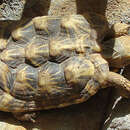Biology
provided by Arkive
Pancake tortoises live in isolated colonies, with many individuals sharing the same kopje, or even crevice (6). Males fight for access to females during the mating season, in January and February, with large males tending to get the most chances to mate (2) (6). Nesting in the wild seems to occur in July and August, although clutches are produced year-round in captivity. The female digs a nest cavity about 7.5 to 10 cm deep in loose, sandy soil (2). Usually only one egg is laid at a time, but a female can lay multiple eggs over the course of a single season, with eggs appearing every four to eight weeks (2) (5). In captivity, the incubation of the eggs lasts from four to six months (6), and young are independent as soon as they hatch (9). Wild and captive specimens often bask and, although they do not appear to hibernate, there are reports that they may aestivate beneath flat rocks during the hottest months (2) (5).
Most activity occurs during the morning hours or in the late afternoon and early evening. The diet primarily consists of dry grasses and vegetation. The pancake tortoise is a fast and agile climber, and is rarely found far from its rocky home so that, if disturbed, it can make a dash for the nearest rock crevice (2).
Conservation
provided by Arkive
In 1981, Kenya banned the export of the pancake tortoise unless given written permission by the Minister for the Environment and Natural Resources. Tanzania protects this species under the Wildlife Conservation (National Game) Order, 1974 (8), and it is protected within the Serengeti National Park (5). CITES quotas also limit the number of these animals that can be exported from Tanzania, although violations of these quotas are thought to occur. The European Union banned the import of the pancake tortoise in 1988, but trade with EU members continues, with several countries having reported importing the species (8). The pancake tortoise has been bred in captivity and is now the subject of a coordinated breeding programme in European Zoos (9). However, there are no commercial breeding operations to supply the market demand, meaning that this unusual and unique tortoise continues to edge ever closer to extinction in the face of human exploitation (8).
Description
provided by Arkive
With its unusually thin, flat, flexible shell, and habit of fleeing rather than withdrawing into its shell, the pancake tortoise is amongst the oddest of all chelonians (4). While the shell bones of most other tortoises are solid, the pancake tortoise has shell bones with many openings, making it lighter and more agile than other tortoises (5). Since this tortoise could easily be torn apart by predators, it must rely on its speed and flexibility to escape from dangerous situations (6). The flexibility of its shell allows the pancake tortoise to crawl into narrow rock crevices to avoid potential predators (2), thus exploiting an environment that no other tortoise is capable of using (7). The carapace is brown, frequently with a variable pattern of radiating dark lines on each scute, helping to camouflage the tortoise in its natural dry habitat (2) (5) (6). The plastron is pale yellow with dark brown seams and light yellow rays (6), and the head, limbs and tail are yellow-brown (2). Sadly, its bizarre, flattened, pancake-like profile makes this tortoise a sought after animal in zoological and private collections, leading to its over-exploitation in the wild (7).
Habitat
provided by Arkive
Found on hillsides with rocky outcrops (known as kopjes) in arid thorn scrub and savannah, from 100 to 6,000 feet above sea level (4) (6) (8).
Range
provided by Arkive
This East African species is native to southern Kenya and northern and eastern Tanzania (6), and an introduced population may also occur in Zimbabwe (1).
Status
provided by Arkive
Classified as Vulnerable (VU) on the IUCN Red List (1) and listed on Appendix II of CITES (3).
Threats
provided by Arkive
The greatest threats facing the pancake tortoise are habitat destruction and over-harvesting for trade. The peculiar appearance and behaviour of this species has heightened its appeal for both zoological and private collections, leading to its over-exploitation (8). Given the low reproductive rate of this tortoise, populations that have been harvested may take a long time to recover. Suitable habitat for pancake tortoises is not common or extensive when found, and habitat destruction is exacerbating the problem (7). Populations in Kenya are threatened by clearance of thorn scrub for conversion to agriculture and, in Tanzania, over-grazing by goats and cattle may be having a negative impact on this tortoise (8).

